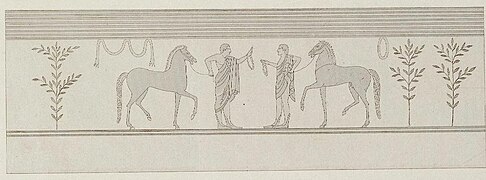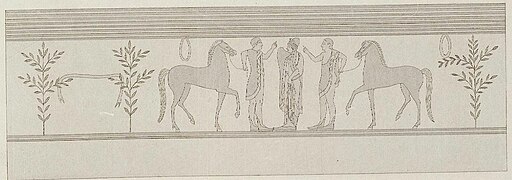Tomba del Barone

The Etruscan Tomba del Barone ("tomb of the baron") was found in 1827 in the Monterozzi necropolis of Tarquinia in central Italy by Baron Otto Magnus von Stackelberg and the diplomat August Kestner and was named for this reason. The grave dates to the end of the sixth century BC. The paintings are well preserved and are considered a highlight of Etruscan art .
description
The walls of the small burial chamber (4.55 × 3.88 × 2.38 meters) have a gray background, which is rather unusual for Etruscan tombs. They are slightly sloped. The ceiling of the burial chamber forms a gable roof. The painted roof beam is supported by two pillars, also painted, on the entrance and back walls. A total of ten figures are depicted on three walls, although there are perhaps only five depicted people. Delicate trees are depicted between the figures on all the walls. On the back wall in the middle stands a woman wearing a tutulus and looking to the left. Two male figures come up to her: a bearded man gives her a drinking bowl ( kylix ) with his left hand , and with his right arm he grips a young man playing the double flute ( aulos ). Riders are approaching on the far left and right. On the left wall you can see a veiled woman in the middle and riders to the left and right who have dismounted from their horses. On the right wall the riders face each other, behind them their horses. Marine animals are depicted in the gable of the rear wall. In the gable of the entrance wall, which is not decorated with the exception of two trees and a wreath, you can find big cats and dolphins.
The paintings only use a limited range of colors. They are black, green, red, yellow ocher and white. The paint is applied thickly so it seems possible that there was overpainting. The outline drawings in black do not match the applied colors several times. Stylistically, the representations are strongly influenced by those from Northern Ionia and are reminiscent of paintings on the Clazomenic sarcophagi . This gave rise to the assumption that the murals were made by a painter from the area around Klazomenai .
interpretation
The interpretation of the individual figures is highly controversial. Explanatory labels are missing and are rather the exception at this time. The riders may be the Dioscurs , who acted as companions for the soul ( psychopompos ), or the sons of the grave owner, who were designed based on the Dioscuri. On two walls in the middle of the wall there is a depiction of a veiled woman. Whether it is the buried woman, a priestess or a goddess is the subject of discussion. For example - as Petra Amann interprets it - the man on the back wall is to be interpreted as the owner of the grave, who offers a libation to a goddess. This sacrifice, in turn, would have taken place in the context of a horse competition ( agon ). In the two riders, the sons of the tomb lord would then be seen as the winners of the competition, whose representation was deliberately adapted to the Dioscuri. Other considerations come to very different conclusions. Accordingly, the paintings may not have had any deeper meaning and were purely decorative.
reception
The wall paintings of the Tomba del Barone were published in 1832 and their motifs were already taken up in 1834 in the ceiling painting of the reception room of King Carlo Alberto of Sardinia-Piedmont in the Castello di Racconigi south of Turin, which was designed as Gabinetto etrusco . The paintings of the chamber grave were drawn throughout the 19th century and even traced on a 1: 1 scale and used for educational wall decoration in museums.
gallery
The paintings as published by Luigi Canina in 1851 :
Individual evidence
- ^ Anne Viola Siebert : August Kestner, Etrurien und die Etruskologie , Hannover 2010, ISBN 9783924029494 , p. 13. The grave was initially called "Tomba del Barone Stackelberg e del Ministro Kestner".
- ^ Moretti, von Matt: Etruscan painting in Tarquinia. , Pp. 74-76
- ↑ Stone graves: Abundance of Life, Etruscan Wall Painting , 98
- ↑ Stone graves: Abundance of Life, Etruscan Wall Painting , pp. 96-98; see. also Natacha Lubtchansky: Divines ou mortelles? Les femmes de la Tombe du Baron à Tarquinia , in: Massa-Pairault, Fran-coise-Hélène (ed.): L'image antique et son interprétation , 2006 online
- ↑ Petra Amann : Die Tomba del Barone , in: Studi Etruschi, 56, 1998 (2001), p. 82.
- ↑ Graeme Barker , Tom Rasmussen: The Etruscans , Malden, Oxford, Victoria, 1998, ISBN 0631220380 , p. 218 (Discuss the option, but are skeptical)
- ↑ Cornelia Weber-Lehmann, Hannes Lehmann: The drawings from the decade 1825 to 1835 . In: Horst Blanck, Cornelia Weber-Lehmann (ed.): Painting of the Etruscans in drawings of the 19th century. Documentation before the photograph from the archive of the German Archaeological Institute in Rome . Exhibition catalog. Verlag Philipp von Zabern, Mainz 1987, ISBN 3-8053-0944-9 , p. 16–41, here p. 26 fig. 4; P. 39, notes 101-102 . - Alessandro Mandolesi, Maria Chiara Ambrosio: Il gusto “all'etrusca” in terra sabauda . In: Alessandro Mandolesi, Maurizio Sannibale (ed.): Etruschi. L'ideale eroico e il vino lucente . Exhibition catalog. Electa, Milan 2012, p. 175–183, especially p. 176 Fig. 2 (Italian, academia.edu [PDF]). - Marinella Marchesi: "Meglio di qualunque descrizione fan conoscere gli usi": le riproduzioni ottocentesche di pitture etrusche a partire dall'esempio del Museo Civico Archeologico di Bologna . In: Il Capitale culturale. Studies on the Value of Cultural Heritage . No. 18 , 2018, ISSN 2039-2362 , p. 393–411, here pp. 398–399 and p. 409 Fig. 6 (Italian, unimc.it [PDF]). - Il Gabinetto Etrusco. 2015 (Italian, color photo).
- ^ Munich and Vatican, Carlo Ruspi: Cornelia Weber-Lehmann, Hannes Lehmann: The drawings from the decade 1825 to 1835 . In: Horst Blanck, Cornelia Weber-Lehmann (ed.): Painting of the Etruscans in drawings of the 19th century. Documentation before the photograph from the archive of the German Archaeological Institute in Rome . Exhibition catalog. Verlag Philipp von Zabern, Mainz 1987, ISBN 3-8053-0944-9 , p. 16-41, especially pp. 23-33 . - Cornelia Weber-Lehmann, Horst Blanck, Hannes Lehmann: Catalog . In: Horst Blanck, Cornelia Weber-Lehmann (ed.): Painting of the Etruscans in drawings of the 19th century. Documentation before the photograph from the archive of the German Archaeological Institute in Rome . Verlag Philipp von Zabern, Mainz 1987, ISBN 3-8053-0944-9 , p. 61–221, here pp. 82–90 . - Copenhagen, Alessandro Morani alias Alessandro Colonelli after Carlo Ruspi: Mette Moltesen, Cornelia Weber-Lehmann: Lebendiges Jenseits. Facsimiles and watercolors of Etruscan tomb paintings. Documentation from the Ny Carlsberg Glyptotek and the Swedish Institute in Rome . Exhibition in the Antikenmuseum Basel and the Ludwig Collection. 2nd Edition. Verlag Philipp von Zabern, Mainz 1995, ISBN 3-8053-1528-7 , p. 68-71 . - Bologna, Luigi Busi: Marinella Marchesi: "Meglio di qualunque descrizione fan conoscere gli usi": le riproduzioni ottocentesche di pitture etrusche a partire dall'esempio del Museo Civico Archeologico di Bologna . In: Il Capitale culturale. Studies on the Value of Cultural Heritage . No. 18 , 2018, ISSN 2039-2362 , p. 393-411 (Italian, unimc.it [PDF]).
literature
- Petra Amann : The Tomba del Barone. Reflections on a new iconological understanding. In: Studi Etruschi. Volume 64, 1998 (2001), pp. 71-93 ( online ).
- Luigi Canina : L'antica Etruria marittima: compresa nella dizione pontificia descritta ed illustrata con i monumenti. Volume 2. Camera Apostolica, Rome 1851, panel LXXXVI ( digitized version ).
- Mario Moretti , Leonard von Matt : Etruscan painting in Tarquinia. DuMont Schauberg, Cologne 1974, ISBN 3-7701-0541-9 , pp. 74–76, figs. 57–61.
- Stephan Steingräber : Abundance of Life, Etruscan Wall Painting . Los Angeles 2006, ISBN 978-0-89236-865-5 , pp. 96-98.
Web links
- Tomba del Barone (Italian)
- Tomba del Barone on Iconography and archeology for pre-Roman Italy (numerous images and extensive bibliography)
Coordinates: 42 ° 14 '26.8 " N , 11 ° 47' 38.6" E


